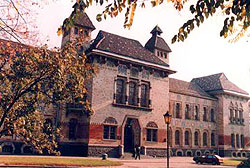About Poltava
 The old town of Poltava situated on the banks of the Vorskla River (a tributary of the Dnepr) is a provincial center in Ukraine. It's an administrative center of Poltava Province. The population of the city is 350,000.
Poltava is the capital of Poltava region, E Ukraine, on the Kiev-Kharkiv highway and on the Vorskla River, a tributary of the Dnieper. It is an industrial center and important rail junction in the rich black-earth agricultural region.
The city has railroad shops, food- and tobacco-processing plants, and factories that produce machinery, railroad equipment, automobiles, tractors, building materials, footwear, leather goods, textiles, and wood products.
One of the oldest Ukrainian cities, Poltava was the site of a Slavic settlement in the 8th and 9th cent. It became part of Lithuania in 1430. In the 17th century, under Bohdan Chmielnicki, it was the chief town of a Ukrainian Cossack regiment. Poltava was a flourishing commercial center in the 18th and 19th century, a principal focus of the Ukrainian literary and national movement, and, under Czar Nicholas I, a place of exile.
What made the city really famous was the Battle of Poltava in 1709 (perhaps the most famous episode in the Great Northern War (1700-1721)).
Poltava was the home of the writer Nikolai Gogol, many of whose stories are set in the nearby village of Dikanka. The city is the location of the gravitational observatory of the Ukrainian Academy of Sciences.
The center of Poltava is the oldest and most beautiful part of town where you will find a lot of especially interesting places. Most of the houses there were built in the 19th - 20th centuries. Dozens of shops, offices and restaurants are situated there, so the streets are never empty, even at night.
The old town of Poltava situated on the banks of the Vorskla River (a tributary of the Dnepr) is a provincial center in Ukraine. It's an administrative center of Poltava Province. The population of the city is 350,000.
Poltava is the capital of Poltava region, E Ukraine, on the Kiev-Kharkiv highway and on the Vorskla River, a tributary of the Dnieper. It is an industrial center and important rail junction in the rich black-earth agricultural region.
The city has railroad shops, food- and tobacco-processing plants, and factories that produce machinery, railroad equipment, automobiles, tractors, building materials, footwear, leather goods, textiles, and wood products.
One of the oldest Ukrainian cities, Poltava was the site of a Slavic settlement in the 8th and 9th cent. It became part of Lithuania in 1430. In the 17th century, under Bohdan Chmielnicki, it was the chief town of a Ukrainian Cossack regiment. Poltava was a flourishing commercial center in the 18th and 19th century, a principal focus of the Ukrainian literary and national movement, and, under Czar Nicholas I, a place of exile.
What made the city really famous was the Battle of Poltava in 1709 (perhaps the most famous episode in the Great Northern War (1700-1721)).
Poltava was the home of the writer Nikolai Gogol, many of whose stories are set in the nearby village of Dikanka. The city is the location of the gravitational observatory of the Ukrainian Academy of Sciences.
The center of Poltava is the oldest and most beautiful part of town where you will find a lot of especially interesting places. Most of the houses there were built in the 19th - 20th centuries. Dozens of shops, offices and restaurants are situated there, so the streets are never empty, even at night.
|